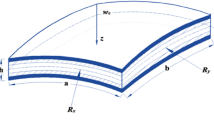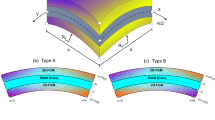Abstract
Distributed dynamic identification and vibration control of high-performance flexible structures has drawn much attention in recent years. This article presents an analytical and finite-element study on a distributed piezoelectric sensor and distributed actuator coupled with flexible shells and plates. The integrated piezoelectric sensor/actuator can monitor the oscillation as well as actively control the structural vibration by the direct/converse piezoelectric effects, respectively. Based on Maxwell's equations and Love's assumptions, new theories on distributed sensing and active vibration control of a generic shell using the distributed piezoelectrics are derived. These theories can be easily simplified to account for plates, cylinders, beams, etc. A new piezoelectric finite element is also formulated using the variational principle and Hamilton's principle. A piezoelectric micropositioning device was first studied; analytical solutions are compared closely with experimental and finite-element results. Distributed vibration identification and control of a zero-curvature shell-a plate-are also investigated.
Similar content being viewed by others
References
H.S. Tzou, “Dynamic analysis and passive control of viscoelastically damped nonlinear dynamic contracts,” J. Finite Elem. Anal. Design, vol. 4, no. 3, pp. 232–238, 1988.
J. Curie and P. Curie, Acad. Science (Paris), vol. 91, pp. 294 and 383, 1880.
E.F. Crawley and J. deLuis, “Use of piezoelectric actuators as elements of intelligent structures,” AIAA J., vol. 25, no. 10, pp. 1373–1385, 1987.
S. Hanagud and M.W. Obal, “Identification of dynamic coupling coefficients in a structure with piezoelectric sensors and actuators,” AIAA paper No. 88-2418, 1988.
J.M. Plump, J.E. Hubbard, and T. Baily, “Nonlinear control of a distributed system: simulation and experimental results,” ASME J. Dynamic Syst. Meas. Control, vol. 109, pp. 133–139, 1987.
A. Baz and S. Poh, “Performance of an active control system with piezoelectric actuators,” J. Sound Vibration, vol. 126, no. 2, pp. 327–343, 1988.
H.S. Tzou, “Active vibration control of flexible structures via converse piezoelectricity,” Dev. Mech., vol. 14-C, pp. 1201–1206, 1987.
C.K. Lee and F.C. Moon, “Modal sensors/actuators,” IBM Research Report, RJ 6306(61975), June 1988.
H.S. Tzou, “Theoretical development of a layered thin shell with internal distributed controllers,”Failure Prevention and Reliability—1989, vol. ASME-DE-16, pp. 241–249, 1989, ASME Design Technical Conference, Montreal, Canada, September 17–20, 1989.
J. Jia and C.A. Rogers, “Formulation of a laminated shell theory incorporating embedded distributed actuators,”Adaptive Structures, AD-vol. 15, ASME WAM, December 1989.
H.S. Tzou, “Distributed modal identification and vibration control of continua: theory and applications,” Proceedings of 1990 American Control Conference, May 23–25, 1990. 1990 American Control Conference: San Diego, CA, 1990, pp. 1237–1243.
H.S. Tzou and M. Gadre, “Theoretical analysis of a multilayered thin shell coupled with piezoelectric shell actuators for distributed vibration controls,” J. Sound Vibration, vol. 132, no. 2, pp. 433–450, 1989.
H.S. Tzou and M. Gadre, “Active vibration isolation by piezoelectric polymer with variable feedback gain,” AIAA J., vol. 26, no. 8, pp. 1014–1017, 1988.
A.B. Palazzolo, R.R. Lin, R.R. Kascak, and R.M. Alexander, “Active control of transient rotordynamic vibration by optimal control methods,” ASME J. Eng. Gas Turbines Power, vol. 111, p. 265, 1989.
H.S. Tzou and C.I. Tseng, “Distributed piezoelectric sensor/actuator design for dynamic measurement/control of distributed parameter systems: a finite-element approach,” J. Sound Vibration, vol. 138, no. 1, pp. 17–34, 1990.
W. Soedel, Vibrations of Shells and Plates. Dekker: New York, 1981.
H. Allik and T.J. Hughes, “Finite element method for piezoelectric vibration,” Int. J. Numerical Meth. Eng., vol. 2, pp. 151–168, 1979.
M. Nailon, R.H. Coursant, and F. Besnier, “Analysis of piezoelectric structures by a finite-element method,” ACTA Electronica, vol. 25, no. 4, pp. 341–362, 1983.
H.S. Tzou, Distributed Piezoelectric Sensors and Actuators: Theory and Applications. Elsevier Science Publishers, BY. Amsterdam, (to appear).
H.S. Tzou and A.J. Schiff, “Development and evaluation of a pseudo-force approximation applied to nonlinear contacts and viscoelastic damping,” Computers & Structures, vol. 26, no. 3, pp. 481–493, 1987.
Author information
Authors and Affiliations
Rights and permissions
About this article
Cite this article
Tzou, H.S., Tseng, C.I. Distributed structural identification and control of shells using distributed piezoelectrics: Theory and finite element analysis. Dynamics and Control 1, 297–320 (1991). https://doi.org/10.1007/BF02169683
Received:
Revised:
Issue Date:
DOI: https://doi.org/10.1007/BF02169683




